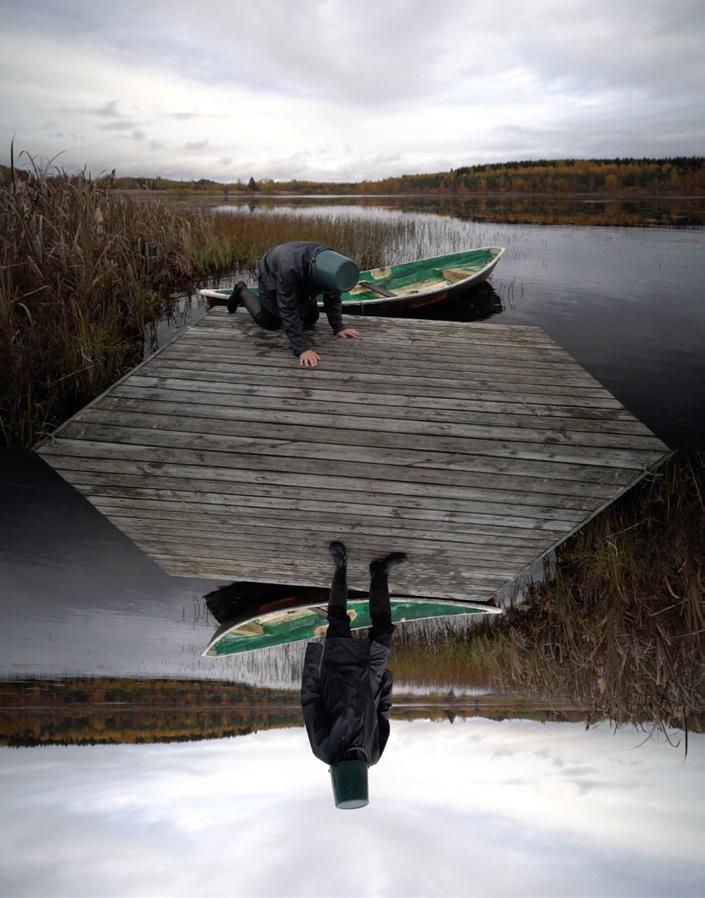
4 minute read
Meet an Artist
DALE COLLIER is a socially engaged interdisciplinary artist of Wiradjuri and Northern European heritage, who experiments with a wide range of media in his practice.

Dale Collier, 'The Cost of Hot Air', 2020, video installation, dimensions variable
Dale grew up on Yuin country, on the South Coast of New South Wales, and now lives and works upon Awabakal, Worimi and Wiradjuri country, in the Hunter region and Central New South Wales.
Dale often travels and participates in artist residencies, so we communicated via email for this interview.
As an artist engaging with a diverse range of media, including sound, text, moving image and installation, Dale focuses on experimental processes. Much of his work across these mediums involves ongoing interrogations of, and interventions into, social constructs of identity, history, and place.

Dale Collier, 'Immeasurable Context', 2019, digital photograph inkjet print on cotton rag, 42 x 42cm
He says he has the overwhelming feeling of existing ‘in-between’ and is motivated by a desire to learn and grow by exploring these issues, which are still problematic and misunderstood in Australian society today.

Dale Collier, 'Leap of Lithobates Pipiens', 2018, performance and composite video still featuring Ryan Danny Owen, Canada. Funded by the Brenda Clouten Memorial Travelling Scholarship.
Dale uses powerful symbols in his work, such as drones, lifebuoys, and hazard tape, to creatively express complex dynamisms and systems. He says the state of the world at the moment blows his mind and that he hopes his projects highlight processes of global conditioning and encourage news ways of thinking about ecological security.
From my experience of Dale’s practice, audience participation is a critical aspect, especially in his installations.
It is both an “enormous privilege” and a responsibility, Dale says, to engage an audience: “A passive audience doesn’t really sit well with what I’m trying to do as an experimental artist.”
Q&A
You were awarded the 2016 Brenda Clouten Memorial Travelling Scholarship. Please tell us about your experience of the scholarship and your trip overseas.
Being awarded the BCMT scholarship in 2016 came as a total shock. I was grateful just to be part of the finalist exhibition.
I remember being kind of awestruck because Nell was one of the judges in 2016; her work is so strong, so consistent. The scholarship made it possible for me to travel overseas for the kind of career development that I wouldn’t have otherwise been able to experience. I took part in an artist residency with ArtScape in Toronto, Canada, where I lived and worked for a month with 11 other artists in studios at Gibraltor Point, Toronto Island, the edge of Lake Ontario. Just before we all landed for the residency there had been cyclones, a really nasty Autumn period with weather conditions that pretty much flooded the island.
It was a really amplified experience and led to a whole lot of new work responding to global conditioning and biospherical crisis.
How has your practice evolved since the Scholarship experience?
Since then I’ve just tried to stay in the flow, keep creating, experimenting with different modes of socially engaged practice. The scholarship experience really pushed me to listen deeper to the things taking effect outside of the white-wall context, beyond museum and gallery environments. So, I’ve been going out on Country making work a lot more. More confidence, more conviction, more connection.
You’re consistently creating new work. Tell us about something you’re currently working on.

Dale Collier, 'Pseudophryne Corroboree', 2020, digital photograph inkjet print on cotton rag, 75 x 53cm
I’ve just finished up at a visiting artist in residence program with the City of Melbourne at the Boyd Community Library, where I was looking into digital/virtual objects and data management systems as process tools for experimental art practice.
We’re going to be putting something together over the next 12 months, which will hopefully be ready for the Cementa Contemporary Art Festival in Kandos in 2021. Other than that, just isolating, doing self-care and playing lots of music!
Interview: Michaela Swan










